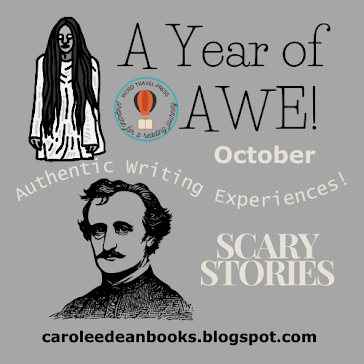Carolee Dean's Blog, page 3
December 2, 2024
ASHA and NCTE 2024
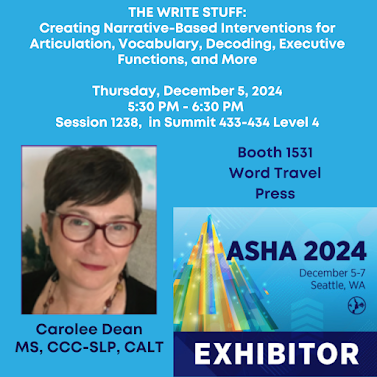
I'm presenting at the ASHA (American-Speech-Language-Hearing Association) Annual 2024 Conference in Seattle on Thursday, December 5, at 5:30pm. If you are at the conference, I will be in Summit 433-434 on the fourth floor. My topic is "The Write Stuff: Creating Narrative-Based Interventions for Articulation, Decoding, Executive Functions, and More." Even if you can't come to the conference, check out my handout packet using the QR code below. The packet will give you a chance to preview the beginning of my new book, The Raven Remix: A Mashup of Poe Titles. All the activities are based on The Raven Remix Activity Book, coming in early 2025.
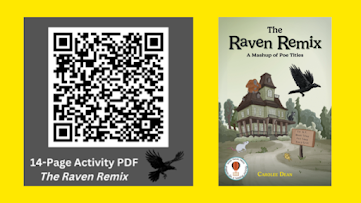
Last week I was in Boston for the NCTE (National Council of Teachers of English) conference, where I spoke on a panel with Jolene Gutierrez, Beth Anderson, and Debbie Myers on the topic of using Illustrated Narrative Non-Fiction as a bridge to traditional non-fiction.
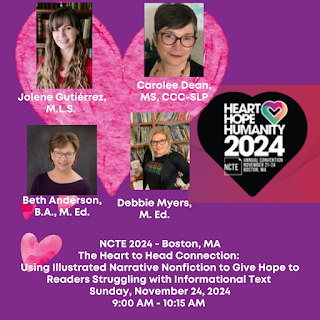
While I was at NCTE, I got the chance to go to dinner at a fun Italian restaurant in the Seaport with Leslie Roessing, who wrote a chapter for my book, Story Frames for Teaching Literacy: Enhancing Student Learning Through the Power of Storytelling. Use the code AF on the Brookes website for a 10% discount. Although I have known her for years, this was the first time I ever met her in person. See my interview with her about Teaching Memoir Writing to Kids. Find her books (The Write to Read and more...) on Amazon. She also has a great website, Literacy with Lesley, which lists her books, informative blog posts on a variety of topics, book reviews, and more reading and writing strategies than I could count. Lyn Miller-Lachman was also part of our dinner party. I interviewed her three years ago, talking about her book, Rogue, and her personal challenges with Asperger's Syndrome. Read that blog post HERE, check out all the new books on her Amazon page, and visit her Website.
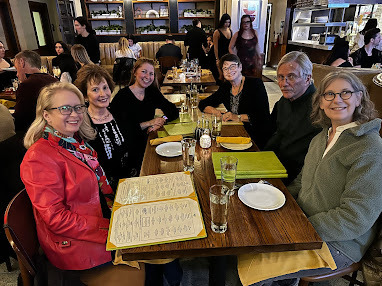
I also got to meet some fun new people, including Jo Watson Hackl (see her Website), author of Smack Dab in the Middle of Maybe, and blogger Melissa Thom. Check out Melissa's author interviews at the Joyful Learning Podcast.
Next year NCTE will be in Denver!! No telling who I might run into then.
November 2, 2024
Authentic Writing Experience for November - Writing Book Reviews
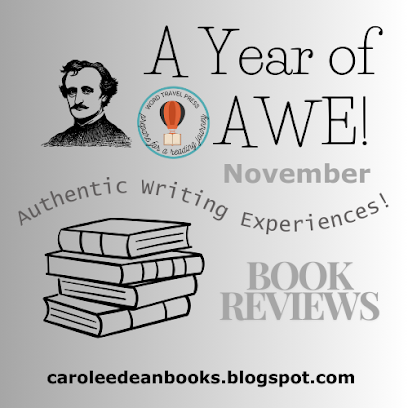
The November Authentic Writing Experience is all about book reviews. Creating book reviews is a great way to work on summary and essay writing, but reviews are so much more than just an old-fashioned book report. They have a real-life purpose. A book review is designed to share impressions and opinions of books with our friends and to get suggestions of books we might like from them. Many adults join book clubs to talk about books. Some prefer movies and enjoy writing reviews for films on sites like Rotten Tomatoes. They also get ideas for movies they might enjoy by reading other people's reviews.
When I worked with high school students on the autism spectrum, we had an after-school moved club. We watched movies, talked about movies, and students wrote movie reviews. Then they filmed each other, giving Siskel and Ebert-style film reviews. The Twilight movie came out around that time, and they even wrote a spoof of the story, acted it out, and filmed it.

While researching my new Edgar Allan Poe book, The Raven Remix, I was surprised to discover that in addition to being a famous poet and short story writer, Poe was also a magazine editor and literary critic. Poe was the first writer to try to make a living solely by his literary efforts, but it was very hard. He lived much of his life in poverty. He received nine dollars for his poem "The Raven" which was not much money even in his time.
To help support himself and his family, Poe wrote hundreds of essays, reviews, and articles that were published in newspapers and magazines. He proposed setting specific standards to judge the merits of literary works. Whenever he critiqued a particular work, he made a detailed technical analysis and often pointed out grammar errors and illogical reasoning. The general public loved his reviews, which were often witty and clever, but the authors he critiqued were not always fans, especially when his remarks were unfavorable. Some of the contemporary authors he reviewed were Henry Wadsworth Longfellow, Ralph Waldo Emerson, Nathaniel Hawthorne, and James Fenimore Cooper.
I don't suggest harshly criticizing your peers, as Poe often did. He lost a lot of friends that way, but writing a book review can be helpful to others who may be interested in reading similar genres.
Here are some tips to share with young people for writing book reviews:
1. Write a one-paragraph summary of the story, but don't give away the ending. Include the title of the book and the author.
2. Write one paragraph describing what you liked or disliked about the book and why others may or may not want to read it. Compare it to similar books that people may know about.
3. Write a conclusion and give the book a 1-5 star rating.
My new decodable book The Raven Remix: A Mashup of Poe Titles is now available on Ingram, Amazon and Barnes & Noble. You can also order it from your favorite local bookstore.
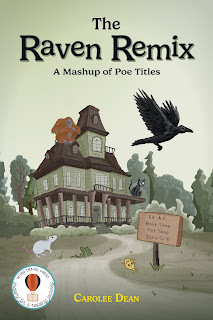 Sign up for my newsletter HERE and receive a free copy of my first decodable book, No Gift for Man. Don't miss any of the fun-filled activities coming up for A Year of AWE: Authentic Writing Experiences.
Sign up for my newsletter HERE and receive a free copy of my first decodable book, No Gift for Man. Don't miss any of the fun-filled activities coming up for A Year of AWE: Authentic Writing Experiences.
October 30, 2024
Happy Halloween - Cause of Death Theory #4 - MURDER
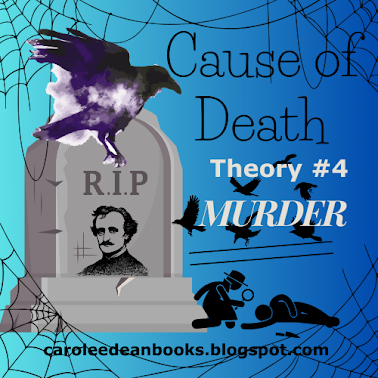
Did someone want Poe dead?
Around the time of Poe's death, there were rumors that robbers had beaten him and taken his possessions, which is why he was wearing strange clothing, but what if he was beaten by someone who knew him? Poe was engaged to marry Elmira Shelton, his high school sweetheart. When they were young, Elmira's father hid Poe's letters from her when Poe went away to college. Elmira ended up marrying another man, but when her husband died, and Poe's wife Virginia died, the two rekindled their romance. Is it possible that someone else in the family also disapproved of the relationship? Perhaps Elmira's brothers?
John Evangelist Walsh wrote an intriguing book called Midnight Dreary: The Mysterious Death of Edgar Allan Poe. He analyzed the last few weeks of Poe's life and came to the conclusion that Poe was killed by someone he knew. Was his death intentional, or was someone just trying to frighten him and they went too far?
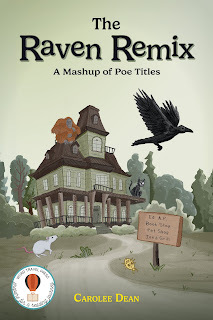
We may never know the real cause of Poe's death, but if you read my new book, The Raven Remix: A Mashup of Poe Titles , you will get to explore several theories about how he died. To review this month's blog posts on the subject, check out the links below.
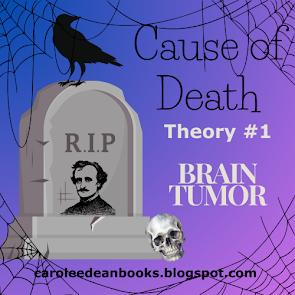
Theory #1 came about when a strange mass was found in Poe's skull when his body was exhumed and moved to a better gravesite.
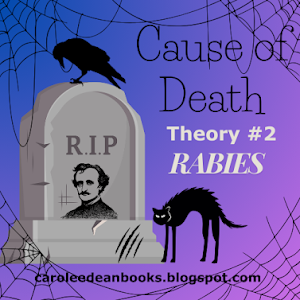
Theory #2 was discussed in the Maryland Medical Journal.
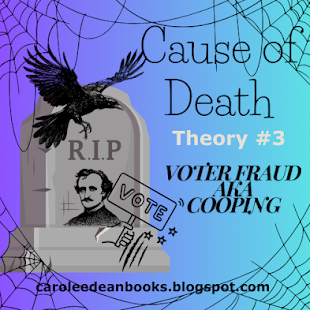
Theory #3 can be traced back to a strange type of voter fraud prevalent in the 1800s.
Sign up HERE for the Carolee Dean, Author newsletter and receive a FREE digital copy of my book, No Gift for Man. You will also receive monthly updates, book news, and FREEBIES.
75th Anniversary of IDA
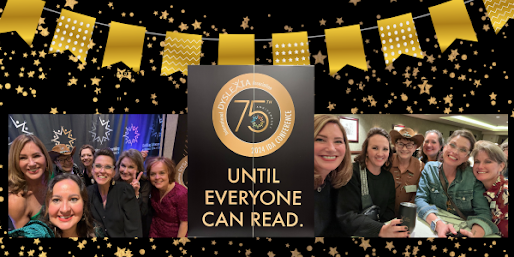
The 75th Anniversary of IDA (International Dyslexia Association) was a stellar event. I had the chance to catch up with old friends and make many more new ones. The beautiful women pictured above are all leaders of the Western Region branches of IDA. I have been very honored to serve as their liaison for the past three years as the Western Region Representative. We all dressed up on Saturday night for a Gala Celebration. Seven Legacy Awards were given out to IDA celebrities like Dr. Reid Lyon, one of the leading experts in reading research.
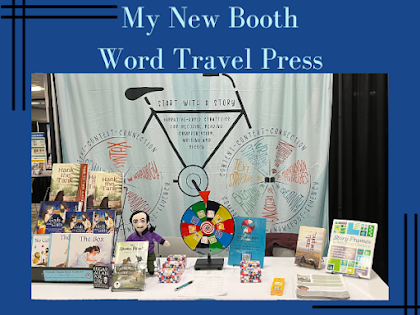
My booth design got a facelift this year with graphics by Sierra Gondrez. The center of each wheel has the image of a book. The focus is to start with a book and then use the content and context to work on the domains of language (phonology, morphology, syntax, semantics, pragmatics) as well as other areas that support literacy such as decoding, executive functions, written language, reading comprehension strategies, creativity, and even articulation (for my SLP friends).
I was thrilled that so many people stopped by to talk about decodable books for older readers and spin the wheel to win a free digital resource. I gave away 5 different online activities to promote the activity books I designed to accompany my HOT ROD series (Higher Order Learning through the Reading of Decodables). I will be highlighting these activities and more starting in January of 2025 in my newsletter, so sign up HERE if you are looking for free digital resources or just want to learn more about decodable books.
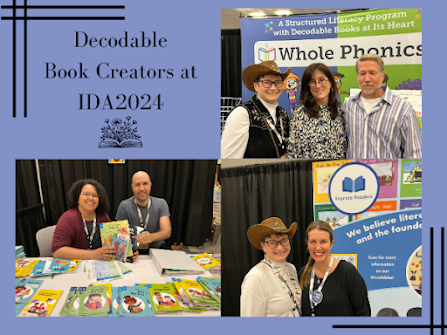
I had a blast connecting with other authors of decodable books in the exhibit hall. Top right is Jill Lauren, creator of the Whole Phonics series and her illustrator, Darren McKee. Bottom right is Elise Lovejoy, creator of Express Readers. Bottom left are Christian and Noemi, the husband and wife team from Canada who are the creators of Wacky Tat books.
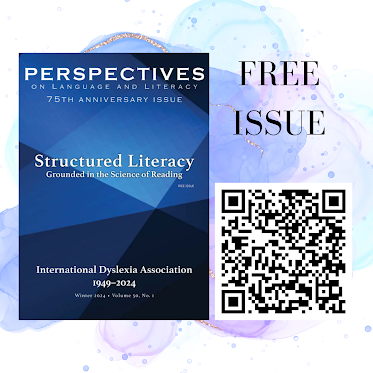 In celebration of their 75th Anniversary, IDA has made a special 75th Anniversary Issue of Perspectives on Language and Literacy. Use the QR code above or click HERE for access. This helpful and practical publication is typically only available to members of IDA.
In celebration of their 75th Anniversary, IDA has made a special 75th Anniversary Issue of Perspectives on Language and Literacy. Use the QR code above or click HERE for access. This helpful and practical publication is typically only available to members of IDA. 
Last but not least, because it ends TODAY, the IDA Speaker Showcase Online Auction ends tonight at 11pm. Check it out and fine a speaker for your next conference. I am one of the featured speakers.
Sign up HERE for the Carolee Dean, Author newsletter and receive a FREE digital copy of my book, No Gift for Man. You will also receive monthly updates, book news, and FREEBIES.
October 28, 2024
POE: Cause of Death - Theory #3 - Voter Fraud (AKA Cooping)
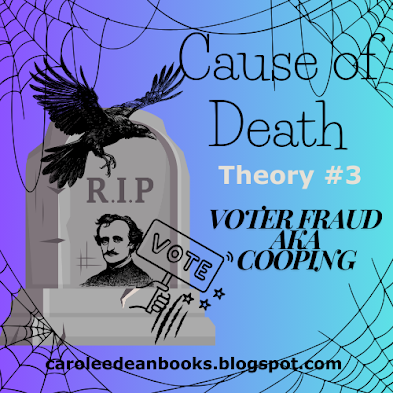
With the presidential election only a week away, it is timely to consider Theory #3 regarding the cause of Edgar Allan Poe's mysterious and untimely death - It's a type of voter fraud prevalent at that time called cooping. Voter registration was hard to track in the 1800s, and voting was not private, so it was fairly easy to vote in more than one location or disguise yourself (or someone else) and vote multiple times at the same location. Voters would get tickets for candidates before the election and then turn in those tickets to a ballot officer at the polling location.
An acquaintance of Poe's found him on October 3, 1849, near Gunner's Hall, which was a tavern serving as a polling location on that particular date. Poe was incoherent, appeared drunk, and was wearing someone else's clothing. He was taken to a hospital, where he died on October 7, 1849.
Cooping was common in Baltimore and other large cities. During cooping, gangs would kidnap victims and force them to vote for a specific candidate multiple times under multiple disguises. They were held or "cooped up" in a secret location and taken out at regular intervals to vote. Victims were often forced to drink alcohol to make them compliant. Alcohol could have worsened whatever other condition Poe may have been suffering from at the time.Poe had little tolerance for alcohol. A doctor had recently told Poe that if he drank again, he would likely die. Poe had recently taken a vow of temperance, meaning that he had made a public promise not to consume alcohol. He was planning to marry his childhood sweetheart, and his prospects for the future looked very promising. Because he had a reputation for drinking, many people assumed he had broken his pledge, but if he was the victim of cooping, he may have been forced to drink against his will.
Fortunately, voting practices have come a long way since 1849! No one has been able to prove the cooping theory, but it might explain why Poe was wearing clothing that didn't belong to him.
To read other theories about the mysterious cause of Poe's death, check out my new decodable book, The Raven Remix: A Mashup of Poe Titles. It is available on Amazon, or you can order it from your favorite local bookstore. For a free writing activity inspired by Poe, see my blog post entitled, Writing Scary Stories. There is still time in October to inspire your students to write a good ghost story.
Sign up HERE for the Carolee Dean, Author newsletter and receive a FREE digital copy of my book, No Gift for Man. You will also receive monthly updates, book news, and FREEBIES.
October 17, 2024
Happy Book Birthday and Another Cause of Death - Theory 2 - Rabies
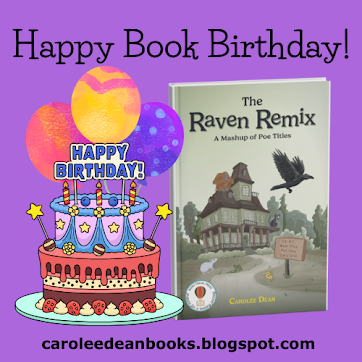
Happy Book Birthday to my new decodable book for grades 5-9 - The Raven Remix: A Mashup of Poe Titles which became available on October 15 on Amazon and Barnes & Noble. You can also order it at bookshop.org and credit your favorite local bookstore. To read more about the book and to preview it on Net Galley, see last week's blog post entitled - The Raven Remix - Just In Time for Halloween and Dyslexia Awareness Month. If you read the book, please leave a review at any of those sites.
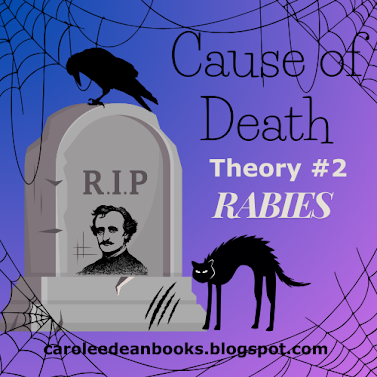
In celebration, I'm sharing excerpts from the background section. That part is not decodable. It's meant to be read to struggling students to provide background knowledge, or it can be shared with a general education classroom of middle school students who can read it independently.
Poe's mysterious death is a mystery that has never been solved, but many fascinating theories have developed over the years. In 1996, a doctor named R. Michael Benitez was given a medical puzzle to solve during a clinical pathological conference. He was provided a patient’s name - E.P., and a list of symptoms, which included lethargy, confusion, delirium, hallucinations, rapid erratic pulse rate, and shallow breathing, with death resulting within four days after admission to the hospital. Dr. Benitez concluded that the patient died of rabies.
The doctor was surprised to discover that the patient described to him was none other than the famous Edgar Allan Poe. Because he did not know the identity of the subject before giving his diagnosis, he was not influenced by any of the previous theories surrounding Poe’s death. However, without DNA evidence, his theory is impossible to prove. Poe also did not suffer from hydrophobia or fear of water, usually associated with rabies. Even so, the Maryland Medical Journal thought Dr. Benitiz’s solution was valid enough to publish in their September 1996 issue.
The hospital where Poe died diagnosed him as having encephalitis, but the specific cause was not given. One type of viral encephalitis that was common at the time Poe died was rabies. If a human is bitten by a mammal (dog, cat, bat) carrying the disease, they can develop rabies encephalitis. This condition leads to many of the symptoms Poe experienced. Read last week's blogpost and Theory #1 - Brain Tumor.
To find out more about the mysterious death of Poe, read my new book, The Raven Remix: A Mashup of Poe Titles.
Sign up HERE for the Carolee Dean, Author newsletter and receive a FREE digital copy of my book, No Gift for Man. You will also receive monthly updates, book news, and FREEBIES.
October 9, 2024
POE: Cause of Death - Theory #1 - Brain Tumor
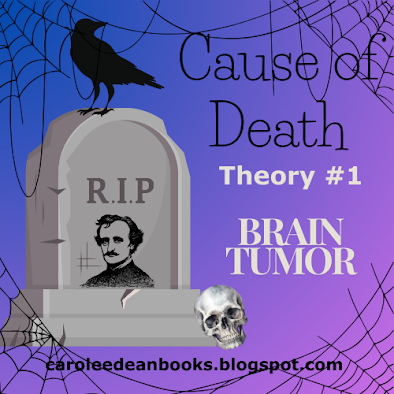
Edgar Allan Poe died under mysterious circumstances at a hospital in Baltimore on October 7, 1849. It was 175 years ago this week! His family and friends back in Richmond didn't even know he was sick until after he was buried in an unmarked grave in the family plot.
No one knows quite how he died. He was found in a tavern in Baltimore on Friday, October 3, by a printer named Joseph Walker, who recognized the famous poet and writer. It was Election Day, and the tavern doubled as a voting location. Walker observed that Poe was semiconscious and dressed strangely in a crumpled shirt, dirty hat, and pants that did not fit him. He was not coherent enough to explain how he arrived at such a state, and he quickly became even more delirious. He was taken to a hospital in Baltimore, where he died four days later. The official cause of death was phrenitis or swelling of the brain, but many conditions can cause that state.
Much speculation has arisen over the years to explain Poe's sudden and mysterious death. Modern science can help us understand one theory, which holds that Poe died of a brain tumor.
Twenty-six years after his death, Poe was exhumed and moved to a better location in the Baltimore graveyard, where a proper monument had been built in his honor. As workers were digging up his coffin, it fell apart. One of the workers observed that a rock-like mass was rolling around in Poe’s skull. Newspaper reports of that time concluded that the think in his skull was Poe’s brain. Scientists today know that the mass could not have been brain matter because the delicate soft tissue is one of the first things to decompose after death. Matthew Pearl was an author who wrote about Poe’s death. He asked a forensic pathologist what the mass might have been. The pathologist confirmed that a brain would not turn into a hard, calcified mass after death, but a brain tumor definitely could.
To find out more about the mysterious death of Poe, read my new book, The Raven Remix: A Mashup of Poe Titles. You can preview the entire book for free until January 2, 2025 on Net Galley. Find out details HERE. Also, watch this BLOG for more fascinating Cause of Death Theories coming each week in October. See this month's free literacy activity on Writing Scary Stories.
Sign up HERE for the Carolee Dean, Author newsletter and receive a FREE digital copy of my book, No Gift for Man. You will also receive monthly updates, book news, and FREEBIES.
October 8, 2024
Authentic Writing Experience for October - Writing Scary Stories
Did you know that Frankenstein was created by Mary Shelley when she was 18 years old on a rainy afternoon when she and her husband, Percy Shelley, and their friend, Lord Byron, were trapped indoors? They didn't have Netflix or cable TV, so they spent their time writing ghost stories and sharing them with each other. Would you like some real-life inspiration for a scary story? Watch the video on the HISTORY website that tells how Mary Shelley carried around her husband's heart after he died.
Or maybe your students would get inspired from reading about the many theories on the death of Edgar Allan Poe. It is a mystery that has never been solved. I explore several theories in the background section of The Raven Remix. This month I will be sharing some of them here on my blog so check back soon! Poe is considered by many to be the father of American Gothic Horror. Elements of several of his stories appear in The Raven Remix. He faced much death and tragedy in his life, and it clearly inspired his writing.
Many of my students have difficulty constructing basic sentences and paragraphs. Writing can be intimidating. For that reason, I'm including a fun fill-in-the-blank story starter for this month's AWE activity. I included a mini word matrix for the base element SPECT (as in specter). There are a series of questions to help students build a complex sentence. To learn more about using the matrix for Structured Word Inquiry and morphology instruction, see my blog post HERE. Find the downloadable PDF for the sentence/story starter HERE. It includes the three pages seen below.
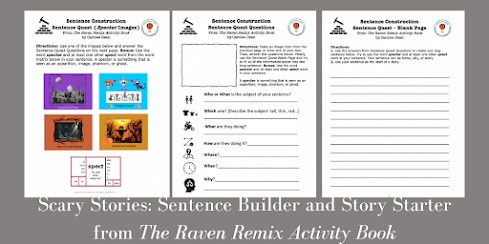 And don't forget to check out The Raven Remix. The five animals on the cover all come from stories by Poe.
And don't forget to check out The Raven Remix. The five animals on the cover all come from stories by Poe.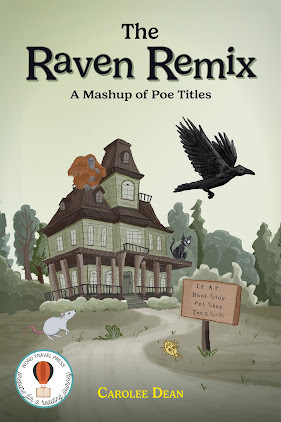
Sign up for my newsletter HERE and receive a free copy of my first decodable book, No Gift for Man. Don't miss any of the fun-filled activities coming up for A Year of AWE: Authentic Writing Experiences.
October 6, 2024
The Raven Remix - Just in Time for Halloween and Dyslexia Awareness Month
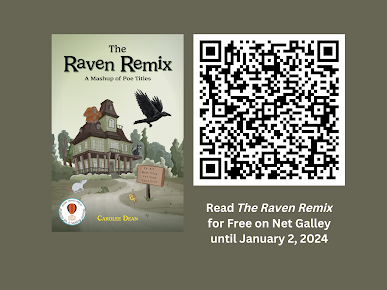
I'm thrilled to announce that my new decodable chapter book, The Raven Remix: A Mashup of Poe Titles will be available for purchase on October 15 in paperback and hardcover - Just in time for Halloween and Dyslexia Awareness Month! You can pre-order the e-book on Amazon. From now until January 2, 2025, you can preview the entire book for free on Net Galley and share the story with your students. If you do, please leave a review. That's the purpose of Net Galley. You may use the QR code above or use the NET GALLEY LINK.
Here are directions for how to read Net Galley books on your computer - https://netgalley.zendesk.com/hc/en-us/articles/115003979634-How-do-I-read-digital-review-copies-on-my-computer.
Here are some early reviews:
“Dean transforms the darker tones of Poe into imaginative humor and mystery. The Raven Remix remains true to Poe’s brilliant use of language, while this delightful, decodable poem provides readers access to the actual meaning of ‘language arts.’ Dean’s work of art is relatable and fun and supports all levels of readers. The Raven Remix can be used in reading instruction and vocabulary development with students from the 5th/6th grades and up, though younger students might enjoy hearing this poem for the lyric rhyming. - Paula Moraine, M. Ed. Author of Helping Students Take Control of Everyday Executive Functions-The Attention Fix and Autism and Everyday Executive Functions
“The Raven Remix will help increase your students’ reading skills while inspiring a sense of wonder. It combines the research, the poetry of storytelling, and a compelling narrative to weave a thought-provoking book perfect for students in 5th grade and higher. Dean has provided a simple introduction to Poe’s exciting work while increasing awareness of the lifelong resilience that many students need. It should be on every classroom shelf.” - Cynthia Barton, LSP, MA, PA, School Psychologist
“Weltner’s grayscale illustrations effectively match the grim tone of Poe’s “The Raven,” and their cartoonish style will engage young readers and improve their comprehension of the text…An unusual alternative introduction to Poe…” Kirkus Reviews
Krista Weltner created the cover image for the Raven Remix and the Illustrations. One of her illustrations from the book is below. A young man visits the Ed A. P. Book Stop, Pet Shop, Inn & Grill to be greeted by a most unusual host. The boy opens a book, and animals from various Poe short stories emerge. The background section includes exciting facts about Poe's life and interesting theories about his death.
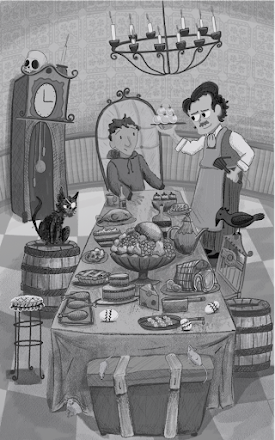
Krista is a talented young artist with dyslexia. See the INTERVIEW I did with her last October for Dyslexia Awareness Month when her picture book series came out.
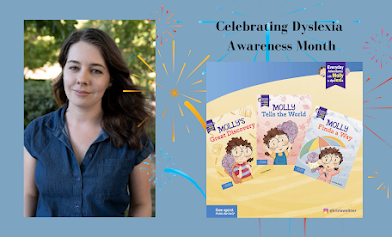
Watch this blog for a month full of scary stories and Poe Trivia. His death is still one of the great unsolved mysteries, but many intriguing theories have developed over the years.
Sign up HERE for the Carolee Dean, Author newsletter and receive a FREE digital copy of my book, No Gift for Man. You will also receive monthly updates, book news, and FREEBIES.
September 25, 2024
Using Narratives to Teach Morphology through Structured Word Inquiry
Structured Word Inquiry is a process used to engage learners in the scientific investigation of word parts and their morphology, etymology, and phonology. It looks at how those elements work together for both meaning and spelling, as well as how they are connected to other words.
The basic idea behind SWI is that English is a highly structured language when you understand the history of words and their underlying meaning. For instance, SWI treats homophones like to, too, two as terms that have important spelling variations to help signal meaning. Rather than being irregular, the word two makes sense when looking at related words like twin and twice.
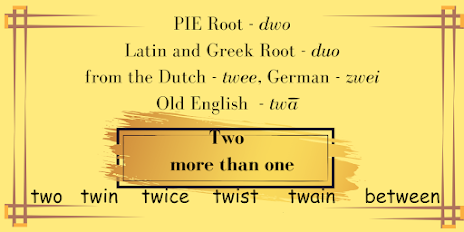
Peter Bowers Ph.D. is the founder of WordWorks Literacy Centre in Ontario. He coined the phrase Structured Word Inquiry (SWI). For more information about SWI, watch his TedX Youth Talk entitled "Make Spelling Joyful Through Scientific Inquiry." He gives tips for "cultivating curiosity" for spelling in students by focusing more on meaning and less on sound. It's 18 minutes long, and he recommends it as an introduction to the big picture of SWI.
Peter's 2009 book - Teaching How the Written Word Works: Using Morphological Problem-Solving to Develop Students' Language Skills & Engagement with the Written Word may be found HERE. I used his book as a reference when I was creating my SWI activities for my activity books. Peter is giving several workshops this fall, and many of them are online. Check out Peter Bowers Workshops.
In my most recent set of narrative-based interventions found in my Gods and Gifts Activity Book, I expanded the section on morphology to include activities for Structured Word Inquiry. My HOT ROD Decodable Books and the accompanying activity books focus on using narratives to improve decoding, reading comprehension, writing, and speech.
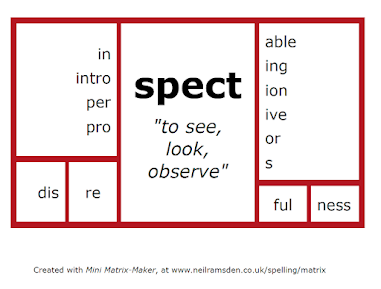
Teaching morphology using Structured Word Inquiry and word sums was a natural addition. The mini-matrix above uses the base element spect - "to see, look, observe." I created it using Neil Ramsden's Mini Matrix-Maker, found at https://www.neilramsden.co.uk/spelling/matrix/. It is fun to note that my decodable book Gods and Gifts, Three Greek Myths Retold is based on Greek Mythology, so exploring Latin and Greek influences was a fun addition.
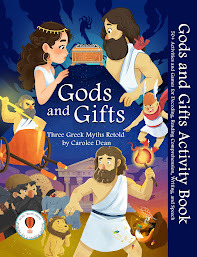
Although I previously included activities for morphology and base elements in my award-winning Hank the Tank Activity Book, I did not include specific Structured Word Inquiry activities. Therefore, I recently created a free supplemental activity for students online using Boom Cards. You can sign up for a free Boom Card membership at https://wow.boomlearning.com
 Created with Mini Matrix Maker, at www.neilramsden.co.un/spelling/matrix
Created with Mini Matrix Maker, at www.neilramsden.co.un/spelling/matrix
Watch for my next Activity Book coming this fall, which is based on The Raven Remix: A Mashup of Poe Titles. The decodable book will be available in paperback and hardcover on October 15 and is available for pre-order now as an ebook on Amazon. If you order the book, please leave a review!
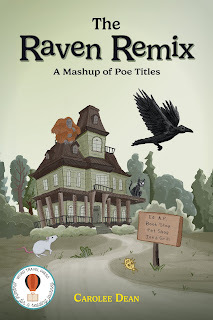
Sign up for my newsletter HERE and receive a free copy of my first decodable book, No Gift for Man. Don't miss any of the fun-filled activities coming up for A Year of AWE: Authentic Writing Experiences. The September writing activity is Museum Fun.

